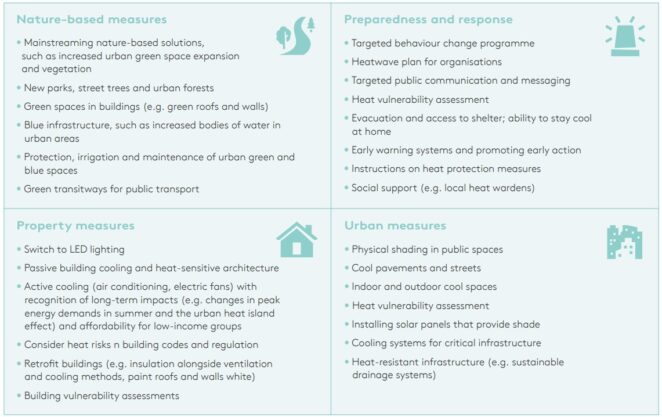The 2022 heatwaves: England’s response and future preparedness for heat risk

Introduction
The summer of 2022 saw unprecedented high temperatures, exceeding 40°C in some parts of the UK. There were more excess heat-related deaths than in previous years, with especially severe health impacts for at-risk groups and vulnerable communities. Furthermore, the heatwaves disrupted transport infrastructure and the utility sectors, and caused economic losses at the local, regional and national levels.
Extreme heat is a relatively new challenge for the UK. There is currently insufficient research, policy or action to ensure that communities, businesses and systems are prepared for this risk and can adequately respond to it and recover from its impacts. The 2022 heatwaves provided an opportunity to evaluate England’s response and resilience to extreme heat events, to advance discussions and stimulate action on this issue. This policy brief sets an agenda for generating this focused discussion.
This article is an abridged version of the original text, which can be downloaded from the right-hand column. Please access the original text for more detail, research purposes, full references, or to quote text.
Methods
Between September 2022 and January 2023 the authors collected time-sensitive data on responses to the 2022 heatwaves. The preparatory research included a literature review, an assessment of heatwave policies, guidance and media coverage, and the creation of a simple system map highlighting the exacerbators of risk along with responses, to reduce the impacts of future heatwaves. Four focus groups were then conducted representing England as a whole, London, Manchester and the Yorkshire and Humber Region, with stakeholders from government and agencies, first responders, utilities and transport and civil society organisations. Thirty-eight semi-structured interviews were carried out with stakeholders from these categories across the four locations.
Responses to the 2022 heatwaves in England
Stakeholders in our focus groups and interviews agreed that the heatwaves were managed relatively well. However, it was felt that resources were at ‘breaking point’, and had the heatwaves been longer in duration or with even higher temperatures, responses would not have been as effective. The stakeholders agreed that England is not prepared to manage future extreme heat events, particularly if these were to occur more frequently at the same magnitude and duration, or if they were less frequent but of greater magnitude than the 2022 heatwaves.
The research highlights that responses to heatwaves in England could be more effective by addressing five key barriers:
1. Limited resources. A lack of dedicated funding for heatwave preparedness and responses at national and local government level and across sectors has been compounded by successive cuts to public budgets. Few staff and personnel have adequate experience and training on heatwaves or extreme heat. Under-staffing during the heatwaves posed challenges. There was also evidence of crisis fatigue following the COVID-19 pandemic.
2. Attitudes and behaviours.Members of the public are not always aware of their vulnerability to extreme heat, and can engage in risky behaviours during heatwaves or periods of extreme heat such as not taking appropriate steps to prevent dehydration and creating fire risk by lighting barbecues in areas where this is not permitted. A general poor understanding about heatwaves often results from a lack of sunburn alerts and signage in open spaces warning people to stay in the shade. The UK does not have a long history of extreme heat hence why the public may not be accustomed to behavioural practices needed to minimise negative impacts of heat to themselves. There is also a scarcity of information on how to stop homes from overheating and how to protect water supplies.
3. Preparedness and strategy. Forward-planning measures and robust processes to deal with heatwaves are not commonplace as heatwaves are seen as exceptional events. Preparedness can be enhanced by actions including water conservation campaigns and scheduled hosepipe pans. There is currently no national strategy for preventing heatwaves from causing overheating in homes and workplaces, and many other negative impacts.
4. Governance. Heatwave response is rarely the product of collaborative, joined-up approaches co-produced by those affected by extreme heat and those involved in delivering responses to extreme heat. There is evidence of working in silos and with conflicting priorities. There is no clear government leadership in the UK when it comes to preparing for extreme heat, in fact most action relating to heatwaves is responsive. More preparedness and preparation are needed to build resilience to future extreme heat events.
5. Knowledge gaps. There is a general lack of understanding about heatwaves and cooling in local government and the buildings sector – particularly over retrofitting existing housing stock. Additional research is needed to better understand challenges arising from ineffective governance, limited resources and expertise, and inadequate communication strategies. A greater understanding of the nature and context of extreme heat risk and how to adapt is also needed, particularly with vulnerable people and communities in mind.
Assessment of current heat wave policy effectiveness in the UK
Numerous policies that would be expected to address heatwaves lack consistency and integration. The accompanying annex identifies weaknesses in existing policies across the six sectors and themes named below, along with suggestions for how they can be improved. They include:
- In the buildings sector, policies do not include a maximum temperature threshold for working. This calls for improvements in policies to consider decarbonisation, overheating and air quality holistically.
- In the health sector, first responders feel under-prepared. Local and regional extreme heat health plans should be developed to incorporate all impacts of heat on health.
- In terms of vulnerable and at-risk groups, there is insufficient understanding of who is vulnerable to extreme heat and why. Policies should better consider a wider range of vulnerable people (e.g. rough sleepers, people with disabilities, people who work outdoors).
- In terms of preparedness, there is also limited understanding of how overheating affects workplaces and education services. Local governments should set a ‘safeguarding response’ minimum temperature threshold above which responses kick in, and invest in solutions for early detection of heat events.
- In terms of climate change adaptation, there is generally a siloed approach to climate mitigation and adaptation and huge variability in local authorities’ ability to produce adaptation plans. This calls for greater interconnectedness between climate mitigation and adaptation agendas, and improved support for local authorities to produce adaptation plans.
- In terms of communication, there is no UK narrative regarding vulnerability to heat, risks of exposure, or the benefits of adaptation. There is a widespread lack of public awareness around the impact of extreme heat, calling for improved public messaging and communication.
Figure 1 below summarises our recommendations for shaping heat-related policies.

To learn more about future-proofing the UK against extreme heat, please refer to the original document.
Policy Recommendations
Update and expand heatwave policy
- Update UK and local government heatwave policies and guidance to ensure all sectors and levels of government are informed, coordinated and prepared for more frequent, severe and extended heatwaves.
- Create local and regional extreme heat action plans and a national heat resilience strategy.The plans must identify funding and finance options, build on existing solutions, and advance nature-based solutions and green technology.
Enhance governance
- Create complementary short- and long-term strategic approaches to heat risk. Improving governance and limiting impacts around heat risk can enhance both short- and long-term responses to heat risk. For example, clarity around roles and responsibilities, avoiding disjointed processes, considering local contexts, tailoring responses to the needs of specific vulnerable groups, and ensuring synergies between mitigation and adaptation measures and approaches to heat.
- Form inclusive, cross-sectoral partnerships to address extreme heat and cascading and compounding climate risks. Extreme heat can interact with other climate-related hazards such as flooding, drought and wildfires, increasing risks to communities, businesses and the built and natural environments. Deep and inclusive cross-sectoral partnerships are needed to manage these complex, compounding impacts.
Encourage a cultural shift
- Improve public communication, education and engagement on extreme heat risk and how people can prepare and respond. This involves increasing effective heat risk communication, targeting specific audiences (especially those most at risk), listening to concerns and feedback, and making heat risk more visible. It is also important to raise awareness of heat as a public health issue as well as a climate change adaptation one.
- Establish a culture of heat in the UK. Over time, the UK will become more exposed to heatwaves of varying frequency, magnitude and duration, so it is important to increase public understanding of the risks, the extent to which populations are vulnerable, and the required behavioural responses. This requires an assessment of current heat risk awareness and a targeted communication and education strategy.
Address knowledge gaps
- More local and regional data and mapping of heat risks and vulnerabilities are needed to prepare for increasing heat risk in the UK. More effective translation and incorporation of such data are also required to inform rapid operational responses and strategic planning.
- Learn from people and places more used to dealing with extreme heat. This can help to fill gaps in knowledge, bolster skills needed for policy and action at home, and enhance agency and efficacy in responding to extreme heat events.
- Identify and understand influences on vulnerable groups to reduce heat disadvantage and vulnerability. Extreme heat compounds risks for vulnerable people, young and old, and amplifies other stressors such as air pollution in urban areas, but many are still unaware of these increasing risks.
Learn more about the recommended actions for heat-related policies in the UK on pages 7 – 8 of the original document.
Conclusion
To improve the UK’s resilience to more intense and frequent extreme heat events, action is needed in many areas, including enhanced political will, sufficient funding, appropriate short- and long-term strategies, improved public messaging and a cultural shift. Further research is also needed to assess public understanding, support and acceptance of heat policies, how to improve communications, and how to influence decision-makers to recognise the risks and impacts of heatwaves and implement appropriate responses.
Suggested Citation:
Howarth C, Armstrong A, McLoughlin N, Murtagh E, Stuart-Watt A (2023) The 2022 heatwaves: England’s response and future preparedness for heat risk. London: Grantham Research Institute on Climate Change and the Environment, London School of Economics and Political Science
Related resources
- Institutional implications for heat related health impacts in the UK
- The IPCC’s 1.5°C Report: increasing risk of heatwaves in African cities
- Hong Kong’s July heatwaves highlight the city’s lack of holistic climate governance
- Communicating climate change attribution: A toolkit for raising risk awareness
(0) Comments
There is no content